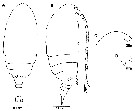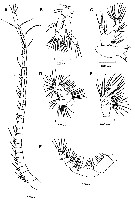|
|
 |
Fiche d'espèce de Copépode |
|
|
Calanoida ( Ordre ) |
|
|
|
Calanoidea ( Superfamille ) |
|
|
|
Paracalanidae ( Famille ) |
|
|
|
Parvocalanus ( Genre ) |
|
|
| |
Parvocalanus arabiensis (Kesarkar & Anil, 2010) (F) | |
| | | | | | | Syn.: | Paracalanus arabiensis : Kesarkar & Anil, 2010 (p.399, figs.F, Table 2) | | | | Ref.: | | | Moon S.Y. & al.., 22014, Table 1, Rem.: p.43-44, p.45: F) |  issued from : K.S. Kesarkar & A.C. Anil in J. Mar. Biol. Ass. U.K., 2010, 90 (2). [p.400, Fig.2]. As Paracalanus arabiensis. Female (from Mandovi and Zuari estuary, Goa): A-B, habitus (dorsal and lateral, respectively); C, forehead with rostrum (lateral); D, rostrum (dorsal). Nota: Head and 1st thoracic segment fused, 4th and 5th with slight demarcation.
|
 issued from : K.S. Kesarkar & A.C. Anil in J. Mar. Biol. Ass. U.K., 2010, 90 (2). [p.401, Fig.3]. As Paracalanus arabiensis. Female: A, A1; B, A2; C, Md; D, Mx1; E, Mx2; F, Mxp. Nota: A1 25-segmented (segments 1 [ancestral segment I] and 2 [ancestral segments II-IV] partially fused, segments 3 [ancestral segment V] to 24 [ancestral segment XXVI] separate, apical segment 25 [ancestral segments XXVII-XXVIII] double, segments 13-24 bear small spines; extending to posterior margin of genital segment. A2 coxa and basis clearly separate; exopod 7-segmented slightly longer than endopod. Md with cutting edge of gnathobase bearing 9 cuspidate teeth and 1 seta; endopod 2-segmented; exopod 5-segmented. Mx1: praecoxal arthrite with 13 setae; coxa with 3 setae on endite; epipodite with 8 setae; basis with 4 setae on proximal endite and 5 setae on distal endite; basal exite with 2 setae; exopod bearing 11 lateral setae; endopod 3-segmented, 1st to 3rd segments with 3, 4 and 7 setae respectively. Mx2: praecoxa bearing 2endites, proximal endite with 6 setae, distal with 3 setae; coxa with 2 endites each armed with 3 setae; basis with 1 endite bearing 4 setae and 1 seta laterally; endopod 3-segmented with setal formula 1, 1, 2. Mxp: praecoxa and coxa apparently separate; praecoxa with 1 seta; coxa bearing 2, 3 and 4 setae representing endites; basis bearing 3 setae; endopod 6-segmented, 1st to 6th segments bearing 2, 4, 4, 3 + 1, and 4 setae respectively.
|
 issued from : K.S. Kesarkar & A.C. Anil in J. Mar. Biol. Ass. U.K., 2010, 90 (2). [p.402, Fig.4]. As Paracalanus arabiensis. Female: A-D, P1 to P5, respectively; E, P5. Nota: P5 2-segmented, symmetrical; 2nd segment bearing 2 terminal spines of unequal length, inner spine twice the length of outer one with a row of 6 small teeth along its edge, 2 small, stiff spines of equal length protrude in between the terminal spines.
|
 issued from : K.S. Kesarkar & A.C. Anil in J. mar. Biol. Ass. UK, 2010, 90 (2); [p.403, Table 2]. As Paracalanus arabiensis. Characteristics of females.
| | | | | NZ: | 1 | | |
|
Carte de distribution de Parvocalanus arabiensis par zones géographiques
|
| | | | | | | Loc: | | | Arabian Sea (Mandovi & Zuari estuaries) | | | | N: | 2 | | | | Lg.: | | | (1046) F: 0,55-0,60; {F: 0,55-0,60} | | | | Rem.: | estuaries.
Moon, Youn & Soh (2014) state that this species shares the generic characteristics of Parvocalanus (see Andronov 1970; Hiromi 1987; Boxshall and Halsey 2004) and that the differences are not relevant enough to put this Arabian taxon in Paracalanus. The authors propose: Parvocalanus arabiensis (Kesarkar & Anil, 2010), comb. n. supported by a Key to the genera of Paracalanidae (emended from Boxshall and Halsey, 2004). | | | Dernière mise à jour : 07/04/2018 | |
|
|
 Toute utilisation de ce site pour une publication sera mentionnée avec la référence suivante : Toute utilisation de ce site pour une publication sera mentionnée avec la référence suivante :
Razouls C., Desreumaux N., Kouwenberg J. et de Bovée F., 2005-2025. - Biodiversité des Copépodes planctoniques marins (morphologie, répartition géographique et données biologiques). Sorbonne Université, CNRS. Disponible sur http://copepodes.obs-banyuls.fr [Accédé le 29 novembre 2025] © copyright 2005-2025 Sorbonne Université, CNRS
|
|
 |
 |






